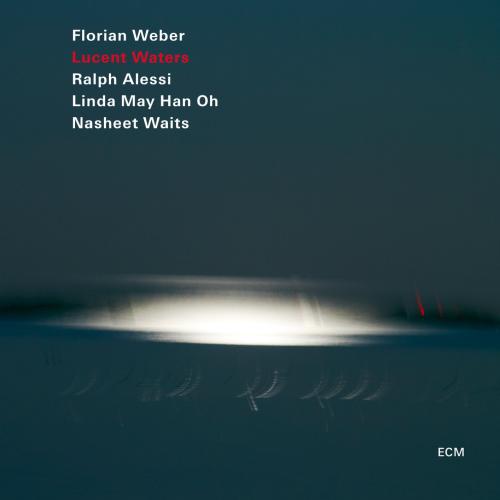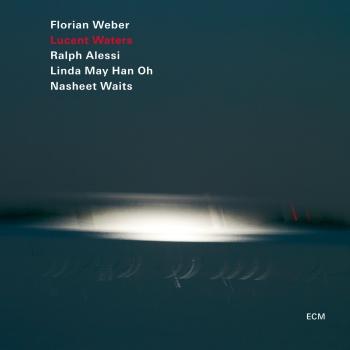
Album info
Album-Release:
2018
HRA-Release:
02.11.2018
Label: ECM Records
Genre: Jazz
Subgenre: Contemporary Jazz
Artist: Florian Weber, Ralph Alessi, Linda May Han Oh, Nasheet Waits
Album including Album cover Booklet (PDF)
I`m sorry!
Dear HIGHRESAUDIO Visitor,
due to territorial constraints and also different releases dates in each country you currently can`t purchase this album. We are updating our release dates twice a week. So, please feel free to check from time-to-time, if the album is available for your country.
We suggest, that you bookmark the album and use our Short List function.
Thank you for your understanding and patience.
Yours sincerely, HIGHRESAUDIO
- 1 Brilliant Waters 02:07
- 2 Melody Of A Waterfall 03:02
- 3 From Cousteau‘s Point Of View 05:37
- 4 Honestlee 07:30
- 5 Butterfly Effect 07:49
- 6 Time Horizon 04:01
- 7 Fragile Cocoon 06:11
- 8 Schimmelreiter 06:01
Info for Lucent Waters
In his second ECM appearance (following a critically-acclaimed duo recording with Markus Stockhausen) pianist Florian Weber leads a strong cast through a programme of his compositions and sketches. Whether paying tribute to mentor Lee Konitz on “Honestlee”, impressionistically conveying the glittering “Melody of a Waterfall” or generating impactful drama out of fragments of sound on “Butterfly Effect”, Weber continually draws fresh responses from his players. “I wanted this project to be as open as possible”, he says. “It’s the idea of exploration that is important here, and the differences between the players.” The strong, grounded bass of Linda May Han Oh contrasts strikingly with Nasheet Waits’s fleet, fluid drumming, setting up new contexts for Ralph Alessi’s elegantly inventive trumpet and the leader’s highly creative piano playing. Lucent Waters was recorded at Studios La Buissonne in the South of France in September 2017, and produced by Manfred Eicher.
Florian Weber’s second ECM appearance, following a critically-acclaimed duo recording (Alba, 2016) with Markus Stockhausen, finds the gifted German pianist leading a newly formed quartet through a programme of his compositions. Openness is key here: whether paying tribute to mentor Lee Konitz on “Honestlee”, impressionistically conveying the glittering “Melody of a Waterfall”, or generating impactful outcomes from fragments of material on a conceptual piece like “Butterfly Effect”, the intention is to encourage fresh responses from the participants.
“I see this album as a meeting of very independently-minded musicians,” says Weber. “It’s the first time I’ve had a band where what particularly interests me is the difference between the players and their approaches to improvising.” He cites the contrast between the soulful, grounded quality of Linda May Han Oh’s bass playing and Nasheet Waits’s fleet, free-flowing drums. “Linda and Nasheet are very different characters, but they balance each other in their exchanging of energies.” The Lucent Waters line-up marks a first collaboration between Weber and Waits, the drummer being recommended by producer Manfred Eicher for the project. “I liked very much Nasheet’s playing on Ralph Alessi’s ECM albums [Baida and Quiver], those are great recordings, so the idea resonated with me.”
Linda May Han Oh and Florian Weber first worked together in trio with Lee Konitz a decade ago. “That was the beginning of a vivid exchange of ideas that has continued in other contexts. For myself, working with Lee night after night taught me what it really means to be spontaneous in the music.” There’s a difference, Weber suggests, between the contemporary emphasis on “self-expression” and “exploring what is actually there, implied in the material and in the interaction of the players.”
Weber and Ralph Alessi have been in and out of each other’s groups for more than 15 years. Latterly, Weber’s been playing in Alessi’s trio with Dan White. “If I look at my career to date, I’ve mostly tried to play with people that I feel close to, that I understand where they’re coming from, emotionally.” Friends, of course, can still challenge each other: “Ralph always says that my writing and playing pushes him to play differently.” This is strikingly evident on “Fragile Coccoon”, where an initially gentle piece bursts open to feature the trumpet in a blazing admixture of lyricism and intensity, framed by Waits dramatically powerful drums.
There are, says Weber, several factors influencing the pieces gathered here. “Pieces emerge, a lot of times, as a feeling or a perspective on some aspect of my life – in this case the twilight atmosphere of the touring musician’s world, and all the ups and downs of that. Then there’s the compositional aspect: I’m always trying to create or shape something which hasn’t, to my knowledge, been there before.”
The degree of freedom given to the players differs from piece to piece. “On ‘Brilliant Waters’, for instance, I didn’t give them much more than the title: that’s a free, open piece, although we end organically on one note, which does sound composed. I did tell the group that I wanted the album to have a sense of narrative, with interconnecting links, of some kind. A motif that appears in one piece might recur in another piece, perhaps reversed. Atmospheric ideas return, two pieces may have a similar instrumental emphasis at certain points, or a soundscape may be similar. As a bandleader I think there’s a fine line between giving musicians too much information and not giving them enough: I wanted the musicians to make their own thing, too.”
Nasheet Waits has the freest role in “Melody of a Waterfall”, which takes its inspiration partly from traditional Japanese drum ensembles: “I like the clarity and focus of that music, its stillness as well as its passion and energy. I find Japanese culture and its ideas fascinating and have tried to understand it – insofar as one can, as a westerner.”
“From Cousteau’s Point Of View” references some recent diving experiences: “The changed three- dimensional perspectives and transparency are central to this tune. Musically it’s 3 against 7, both times going on at the same time, and you’re not sure which one you should follow. I like transparency, but too much of it can make the mystery disappear. And I also like the mystery, just as I like the things that are not said, and the notes not played.”
“Honestlee”, dedicated to Lee Konitz (“every time I meet Lee I learn something new” says Florian), incorporates “some Lennie Tristano School ideas, but not Tristano-style playing. It explores some ideas he had about lines and counterpoint.” The piece also takes impetus from drawings which Karlheinz Stockhausen made at Darmstadt. “The drawings illustrate some polyphonic concepts. I looked at them and immediately wanted to write a tune. Wanting to dedicate something to Lee, the ideas converged. So we start with lines and then go into open mode.” Weber’s playing, exemplary throughout, is particularly affecting here. (Konitz, on hearing this recording, has said “Florian is one of the most creative piano players I have ever played with. His music is totally free. He has got the texture, the feeling, just beautiful. I am very touched by this music. It feels divine to me.“)
Florian Weber, piano
Ralph Alessi, trumpet
Linda May Han Oh, double bass
Nasheet Waits, drums
Florian Weber
a German Jazz Critics Prize winner who has worked with the likes of Tomasz Stańko, Michael Brecker, Pat Metheny and Albert Mangelsdorff, made his ECM debut on the 2016 duo session Alba in collaboration with trumpeter Markus Stockhausen after having garnered much acclaim for a string of recordings with saxophonist Lee Konitz. His quartet leader date Lucent Waters followed in 2018, seeing the pianist paired with an American all-star cast of trumpeter Ralph Alessi, Linda Oh and Nasheet waits. The album was received with great enthusiasm. Downbeat magazine: “Weber’s compositions straddle jazz and the avant-garde seamlessly. The emphasis is on economy and beauty; it’s hard to resist the melting of colors of the compositions, the delicate touch of the players and the seductive calm of the tempi. […] The delicate, kinetic execution of Weber’s exquisite, often pensive compositions at times conveys the rejuvenating splendour of savouring crisp spring water.”
A master improviser with an equal interest for notated music – Florian also performs traditional classical repertory and original compositions alongside international orchestras –, Weber has appeared on ECM as part of Matthieu Bordenave’s groups on La Traversée and The Blue Land, as well as on Ralph Alessi’s 2023 quartet recording It’s Always Now. Released in Autumn 2024, Weber’s Imaginary Cycle is a hybrid of multiple musical languages that seamlessly blends the harmonious with the oblique, conceived for the unique instrumentation of brass ensemble and piano. On the album Weber presents a cycle in four parts, plus an opening and an epilogue, in which the pianist is accompanied by a group of four euphoniums, a trombone quartet as well as flautist Anna-Lena Schnabel and Michel Godard on the seldomely used “serpent” brass instrument, together performing a work that blurs the line where improvisation ends and composition begins.
Weber’s compositions straddle jazz and the avant-garde seamlessly. The emphasis is on economy and beauty; it’s hard to resist the melting of colors of the compositions, the delicate touch of the players and the seductive calm of the tempi. […] The delicate, kinetic execution of Weber’s exquisite, often pensive compositions at times conveys the rejuvenating splendour of savouring crisp spring water. – Downbeat magazine on Weber’s Lucent Waters
Florian Weber has established himself as one of the most enigmatic and accomplished pianists and composers between the genres in Europe and beyond – the online magazine Something Else! has called him “a truly forward thinking pianist… astonishing!”, while the German daily Süddeutsche Zeitung hailed him as “an exceptional pianist with a fresh new sound.” Since his ECM debut in duo with Markus Stockhausen on 2016’s Alba, Weber has gone from strength to strength, garnering awards, commissions and spotlights in international festivals.
He released his leader recording Lucent Waters in 2018, playing alongside trumpeter Ralph Alessi, Nasheet Waits on drums and bassist Linda May Oh. As a sideman, the pianist appears on both Matthieu Bordenave albums (La Traversée, The Blue Land) and Ralph Alessi’s It’s Always Now (“Immediately one senses Weber to be an ideal harmonic partner, able to anticipate and gently react to Alessi’s movements, which are by no means predictable” – Making A Scene).
Booklet for Lucent Waters











